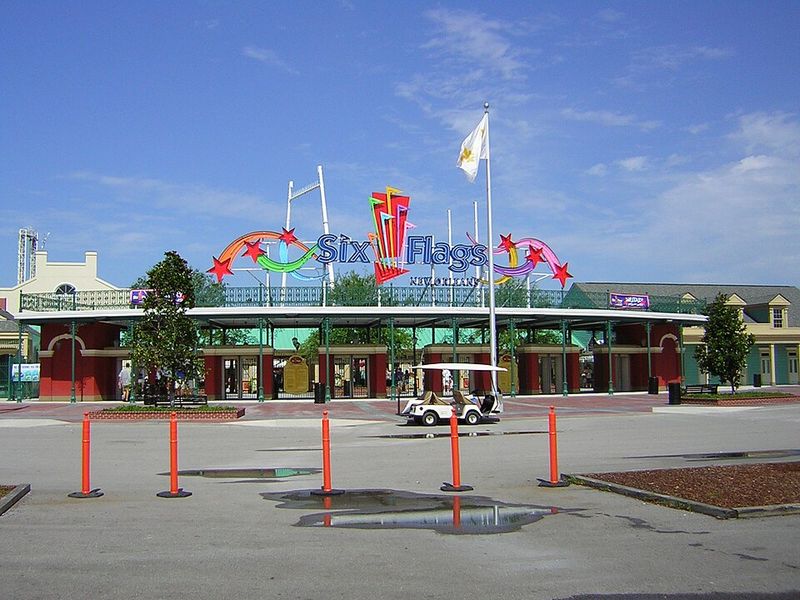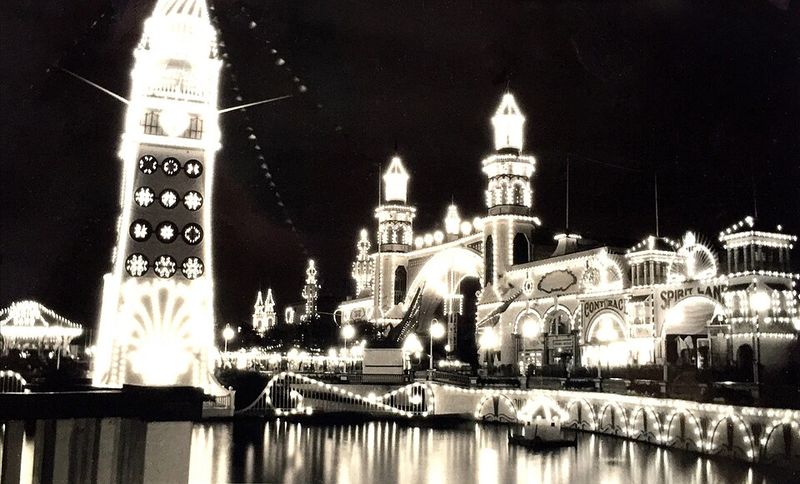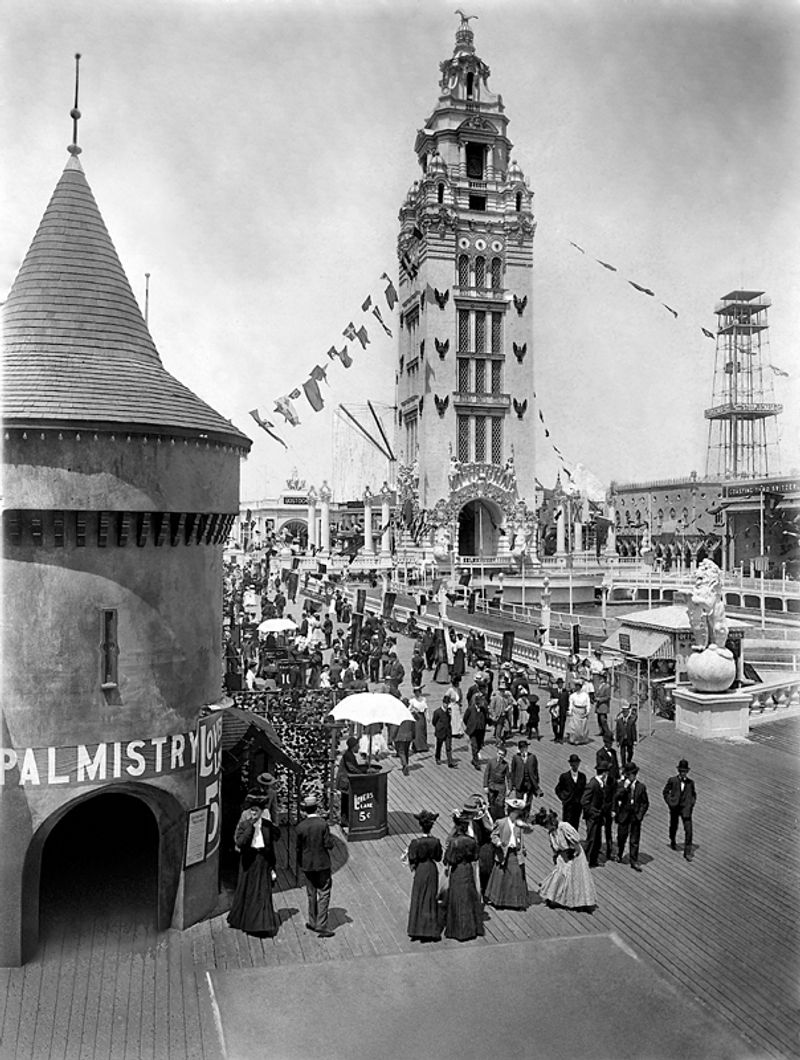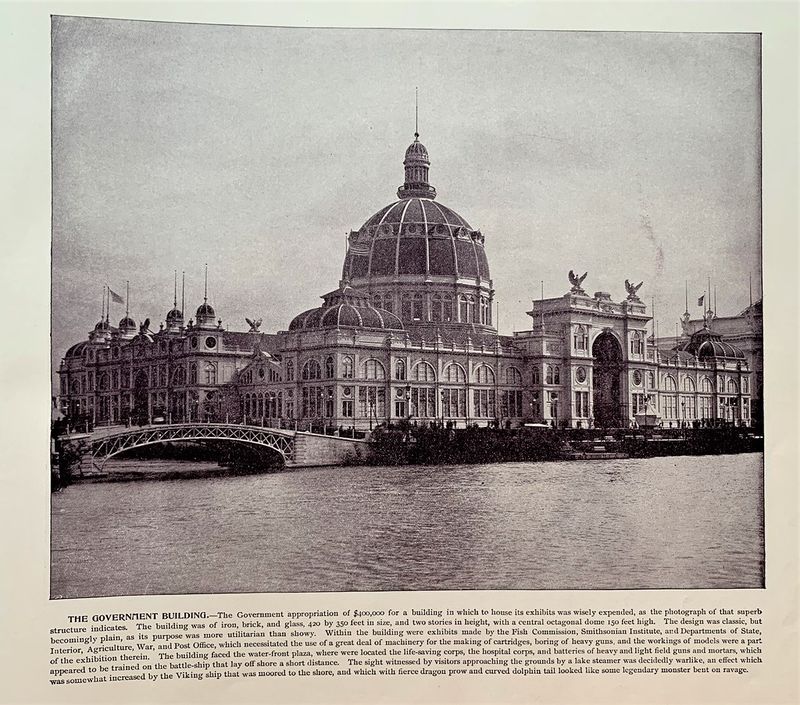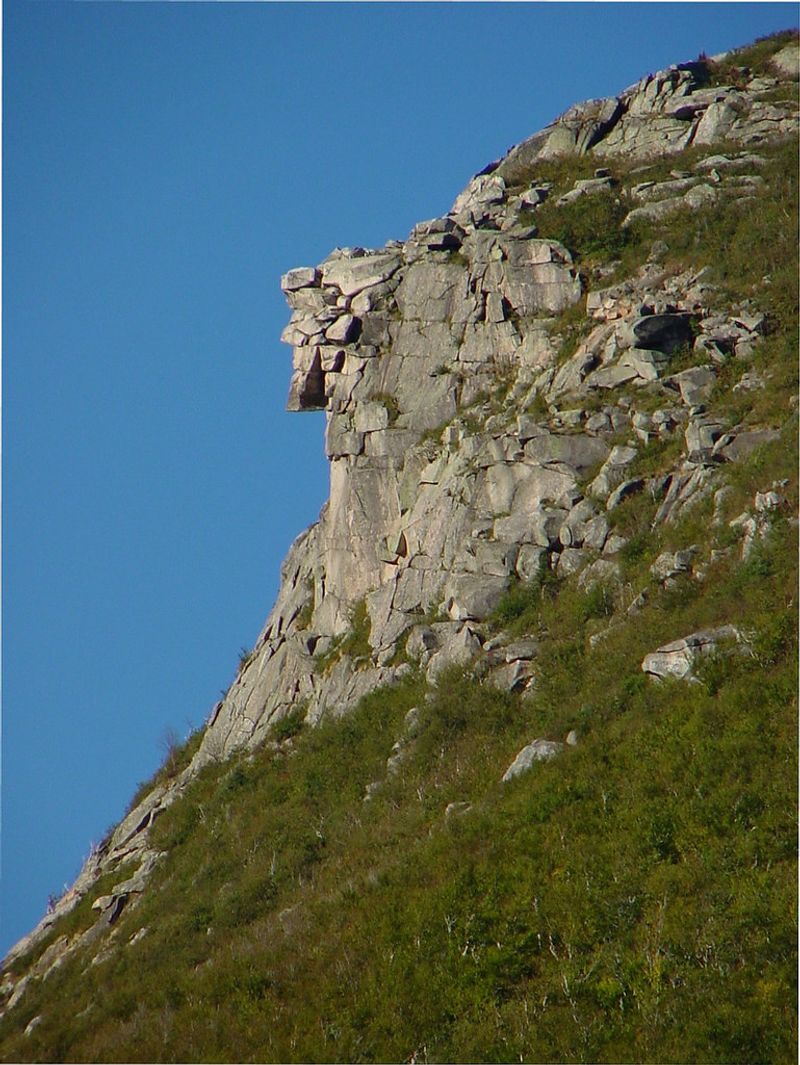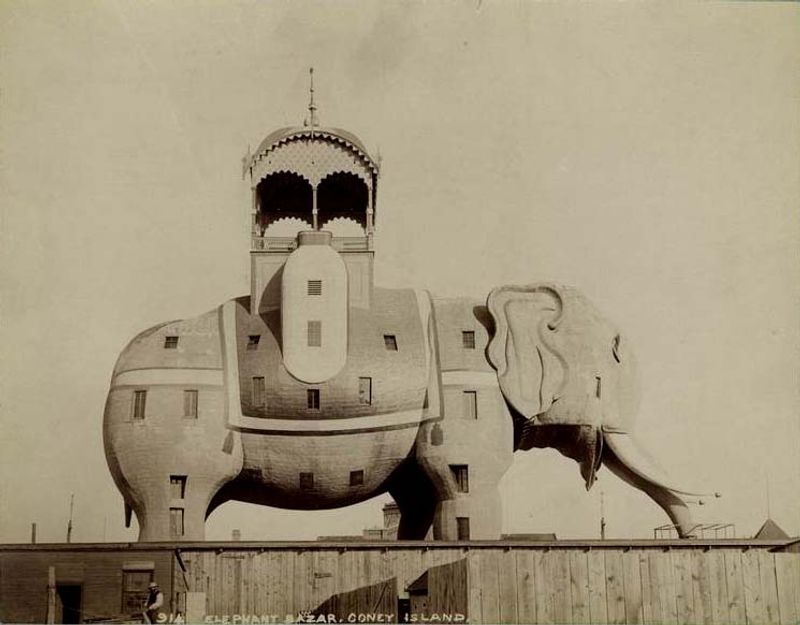America’s landscape has changed dramatically over the centuries, with some of its most beloved landmarks vanishing in moments of tragedy. Fires, hurricanes, collapses, and demolitions have claimed structures that once defined cities and captured imaginations. Many of these attractions were engineering marvels or entertainment destinations that drew millions of visitors. Their stories remind us how fragile even the most impressive human creations can be.
1. The Old Penn Station in New York
Pennsylvania Station stood as one of New York City’s architectural masterpieces from 1910 until its demolition in 1963. Modeled after Roman baths, the station featured soaring pink granite columns and glass ceilings that flooded the space with natural light. Travelers felt transported to ancient Rome while catching their trains.
The decision to tear it down sparked outrage among preservationists and everyday New Yorkers alike. Its destruction directly led to the creation of the city’s Landmarks Preservation Commission. Today, commuters navigate a cramped underground replacement that lacks any of the original’s grandeur. The loss remains one of architecture’s greatest tragedies.
2. Crystal Palace in New York
Built for the 1853 Exhibition of the Industry of All Nations, the Crystal Palace was America’s answer to London’s famous glass structure. This iron and glass marvel rose in what is now Bryant Park, showcasing innovations and art from around the world. Sunlight poured through thousands of glass panes, creating a magical atmosphere.
On October 5, 1858, a fire broke out and consumed the entire building in less than an hour. The flames were so intense that the glass melted and the iron frame collapsed into twisted ruins. Miraculously, only one person died in the blaze. Nothing remains today except historical engravings and memories.
3. Six Flags New Orleans in Louisiana
Once known as Jazzland, this theme park opened in 2000 and became Six Flags New Orleans in 2003. Families enjoyed roller coasters, water rides, and entertainment themed around Louisiana culture. The park brought joy to countless children during summer vacations.
Hurricane Katrina struck in August 2005, flooding the entire park under several feet of contaminated water. Rides rusted, buildings molded, and nature began reclaiming the property. The park never reopened, and its eerie remains became a popular spot for urban explorers. After years of legal battles, demolition finally began in 2021, erasing what Hurricane Katrina had left behind.
4. MGM Grand Hotel in Las Vegas
Las Vegas’s MGM Grand Hotel was the city’s largest resort when fire broke out on November 21, 1980. What started in a restaurant quickly spread through the building, fueled by flammable materials and poor fire safety systems. Thick smoke filled hallways and stairwells, trapping guests on upper floors.
The disaster claimed 85 lives, making it one of America’s deadliest hotel fires. Most victims died from smoke inhalation, not flames. The tragedy led to stricter fire codes nationwide. The building was eventually rebuilt and later became Bally’s Las Vegas. The original MGM Grand’s glamorous facade couldn’t protect those inside from poor safety standards.
5. Winecoff Hotel in Atlanta
Atlanta’s Winecoff Hotel advertised itself as absolutely fireproof, a claim that proved tragically false on December 7, 1946. The 15-story building had no fire escapes, sprinklers, or fire doors. When flames erupted around 3:00 AM, guests found themselves trapped in a towering inferno.
Desperate people jumped from windows or tried climbing down makeshift rope ladders. The fire killed 119 people, including the hotel’s owner, making it America’s deadliest hotel fire ever. Photos of the disaster shocked the nation and changed building codes forever. Though the structure survived and operates today as an apartment building, its interior was completely destroyed that night.
6. Sutro Baths in San Francisco
Adolph Sutro built these elaborate public baths in 1896, creating the world’s largest indoor swimming facility. Seven pools of varying temperatures and sizes sat beneath a massive glass roof, accommodating 10,000 people at once. Visitors could also enjoy museums, restaurants, and even a skating rink on the premises.
By the 1960s, maintenance costs had become overwhelming, and the facility closed in 1966. Later that same year, a suspicious fire destroyed what remained of the structure. Today, only concrete ruins sit along the rocky San Francisco coastline. The site offers stunning ocean views but no hint of its former grandeur.
7. Luna Park Original at Coney Island
Opening in 1903, Luna Park transformed Coney Island into America’s premier amusement destination. Over one million electric lights outlined its fantastic towers and attractions, earning it the nickname Electric Eden. Visitors rode thrilling attractions and marveled at exotic shows and spectacles unavailable anywhere else.
Fire broke out on August 12, 1944, during a particularly dry summer. Flames raced through the aging wooden structures, consuming decades of memories in hours. Only a few brick buildings survived the inferno. Though a new Luna Park opened nearby in 2010, it bears no resemblance to the original’s fantastical architecture. The magic of that first Luna Park can never be recreated.
8. Dreamland at Coney Island
Dreamland opened in 1904 as Coney Island’s most ambitious amusement park, featuring a million lights and attractions that pushed the boundaries of imagination. A 375-foot tower welcomed visitors to this white city by the sea. Inside, guests could witness reenactments of disasters, visit premature babies in incubators, or ride elaborate mechanical attractions.
On May 27, 1911, a fire started in the Hell Gate ride and quickly engulfed the entire park. Strong winds spread flames across the wooden structures within hours. One person and several animals from the park’s exhibits died in the blaze. Dreamland never rebuilt, leaving only photographs to document its brief but spectacular existence.
9. Cliff House Gingerbread Palace in San Francisco
Perched dramatically on cliffs overlooking the Pacific Ocean, the Victorian Cliff House was a seven-story architectural fantasy. Built in 1896 by Adolph Sutro, it featured elaborate gingerbread trim, turrets, and observation decks. Wealthy San Franciscans dined there while watching the sunset over crashing waves.
On September 7, 1907, fire destroyed this ornate structure completely. Some suspected arson, but the cause was never definitively proven. A simpler building replaced it, which still operates today as a restaurant. The elaborate Victorian palace, however, exists only in old photographs. Its loss robbed San Francisco of one of its most distinctive and whimsical landmarks along the coast.
10. Chicago World’s Fair White City Buildings
The 1893 World’s Columbian Exposition created a temporary city of white neoclassical buildings that dazzled 27 million visitors. Architects designed grand halls around lagoons and fountains, creating an idealized vision of urban beauty. Electric lights illuminated the White City at night, introducing many Americans to this new technology.
Most structures were built from temporary materials and meant to be demolished after the fair. However, fires in 1894 and subsequent years destroyed many before planned removal could occur. The Palace of Fine Arts survived until 1933. Today, only the Museum of Science and Industry remains from this magical white city. The fair’s influence on American architecture and culture far outlasted its physical structures.
11. Electric Tower in Buffalo
Standing 391 feet tall, Buffalo’s Electric Tower was completed in 1912 as a celebration of the city’s role in electrical innovation. Thousands of light bulbs outlined its Spanish Renaissance architecture, making it visible for miles. The building housed offices and represented Buffalo’s position as a center of progress and industry.
Lightning struck the tower in 1956, starting a fire that severely damaged the upper floors and distinctive crown. Though the building survived and still stands today, its elaborate top section was never restored. The simplified replacement lacks the original’s ornate beauty and illuminated grandeur. Buffalo lost a defining piece of its skyline that night, even though the structure itself remained.
12. Old Man of the Mountain in New Hampshire
For thousands of years, five granite ledges naturally formed a 40-foot tall profile on Cannon Mountain. This geological coincidence became New Hampshire’s most famous landmark and appeared on everything from license plates to quarters. Generations of families stopped to photograph this stern stone face gazing across Franconia Notch.
On May 3, 2003, the formation collapsed overnight due to natural weathering and freeze-thaw cycles. Workers had used cables and epoxy for decades to hold the rocks together, but nature eventually won. Residents mourned the loss like that of an old friend. Today, only a blank cliff face remains where the Old Man once watched over New Hampshire.
13. Great Saltair Pavilion in Utah
Built in 1893 on the shores of the Great Salt Lake, Saltair was a massive resort featuring Moorish architecture with domes and minarets. Visitors arrived by train to swim in the salty water, dance in the grand ballroom, and enjoy entertainment. At its peak, 500,000 people visited annually, making it Utah’s premier attraction.
Saltair suffered multiple disasters across decades, including fires in 1925 and 1970, plus flood damage. Each time it was rebuilt, but never to its original grandeur. The final version closed in 1958, and subsequent attempts at revival failed. Today, only pilings and memories remain of this once-magnificent palace by the lake. Nature and economics proved too powerful to overcome.
14. Gulf Coast Boardwalks in Mississippi and Louisiana
The Gulf Coast’s boardwalks stretched along beaches in Mississippi and Louisiana, offering family entertainment for generations. Amusement rides, seafood restaurants, arcades, and souvenir shops drew millions of visitors each summer. These wooden walkways represented the heart of Gulf Coast tourism and local culture.
Hurricane Katrina’s 28-foot storm surge on August 29, 2005, obliterated entire sections of these boardwalks. Casinos, piers, and entertainment districts were reduced to splinters scattered across the landscape. Some communities rebuilt portions, but many areas never recovered. The storm fundamentally changed the Gulf Coast’s character. What took a century to build vanished in a single day, taking countless memories and livelihoods with it.
15. Elephantine Colossus at Coney Island
Imagine a building shaped like a 122-foot tall elephant with rooms inside its legs and body. That was the Elephantine Colossus, built in 1885 as Coney Island’s strangest attraction. Visitors climbed spiral staircases through the structure and enjoyed views from the howdah on top. The ground floor housed a museum and shops.
This bizarre architectural experiment never achieved financial success and changed hands multiple times. On September 27, 1896, fire consumed the massive wooden structure in spectacular fashion. Flames shot from the elephant’s eyes and trunk as horrified crowds watched. The site was cleared, and nothing like it was ever built again. The Colossus remains one of America’s most unusual lost landmarks.


